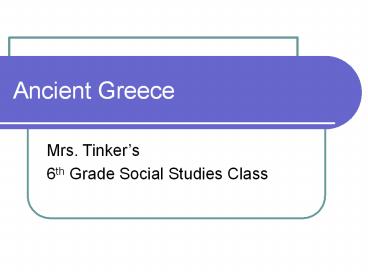Ancient Greece - PowerPoint PPT Presentation
Title:
Ancient Greece
Description:
Ancient Greece Mrs. Tinker s 6th Grade Social Studies Class – PowerPoint PPT presentation
Number of Views:220
Avg rating:3.0/5.0
Title: Ancient Greece
1
Ancient Greece
- Mrs. Tinkers
- 6th Grade Social Studies Class
2
The Greek Peninsula
3
The Greek Peninsula
- Greece is a peninsula, which means that it is
surrounded on three sides by water. - Greece has a lot of smaller peninsulas sticking
out from it, which means Greece enjoys many
natural harbors.
4
Rugged Land
- Greece is covered with mountains. They are not
huge mountains but if you are trying to go from
place to place in Greece, you'll find the
mountains a bit of a hindrance. - The highest mountain in Greece is Mount Olympus.
5
Mount Olympus
6
Rugged People
- Making a living was difficult. The growing season
tended to be dry. - There are not great rives for irrigation and
fresh water came from shallow streams. - Farm crops consisted of wheat, barley, and beans.
Citrus trees and grapevines grew on the
hillsides. Olive trees gave food and oil. Sheep,
goats and cattle gave milk, cheese and meat.
7
Common Foods in Ancient Greece
8
Importance of the Sea
- The sea was an important to the people of ancient
Greece. It was easier to travel by the sea than
the mountains. - The population grew and people moved from the
mainland to the islands surrounding the mainland.
9
Trade Routes
- Greek merchants established trade routes among
the colonies and with many cities along the
coasts of Aegean and Mediterranean seas.
10
Earliest Settlers
- The earliest civilization began on the island of
Crete. - The people are called the Minoans after their
legendary king, Minos.
11
The Minoan Era
- The Minoan king lived in the capital city of
Knossos, in a maze of a palace with 1500 rooms!
It was a gorgeous palace. But during Minoan
times, even poor people on the island of Crete
had 4-room houses, with running water for
drinking and bathing, and bathrooms that
flushed! This was a very advanced civilization.
12
The Minoan Era
- The Minoan king lived in the capital city of
Knossos, in a maze of a palace with 1500 rooms!
It was a gorgeous palace. But during Minoan
times, even poor people on the island of Crete
had 4-room houses, with running water for
drinking and bathing, and bathrooms that
flushed! This was a very advanced civilization.
The ancient Minoans did have a written language.
Far more than the records they left behind, the
paintings on the walls of the palace at Knossos
share the daily life of these ancient people.
Some walls were painted with pictures of starfish
and water scenes, much as you would expect from a
civilization that lived on an island.
13
The Minoan Palace
14
The Minoan Era
- The ancient Minoans did have a written language.
Far more than the records they left behind, the
paintings on the walls of the palace at Knossos
share the daily life of these ancient people.
Some walls were painted with pictures of starfish
and water scenes, much as you would expect from a
civilization that lived on an island.
15
The Minoan Era
- But some walls were painted with pictures of
young people, both boys and girls, jumping over
bulls. Scholars believed that bull jumping must
have been a very popular sport in Minoan times. - The artwork consisted of Frescoes, a painting
made with watercolors on wet plaster.
16
The Minoan Era
- Around 1700 BCE, an earthquake hit Crete. Much of
the Minoan civilization was destroyed. The
Minoans rebuilt. Around 1500 BCE, a volcano
erupted near the island of Crete. Tidal waves
followed the eruption. - The Minoans might have been wiped out by natural
disaster or by war. There were warrior tribes on
the mainland of Greece. But scholars believe the
tidal waves certainly weakened them. Whatever the
cause, around 1500 BCE, this civilization
disappeared from the island of Crete.
17
The Minoan Era
- The Minoans might have been wiped out by natural
disaster or by war. There were warrior tribes on
the mainland of Greece. But scholars believe the
tidal waves certainly weakened them. Whatever the
cause, around 1500 BCE, this civilization
disappeared from the island of Crete.
18
The End to the Minoan Era
- http//www.youtube.com/watch?vVJoc9Flq4XE
19
Mycenaeans Rule
- Myceaeans were devoted to warfare. Their palaces
were strong-walled fortresses called Citadels. - Each Citadels was the center of a small community
ruled by a king. The king controlled the
activities of the villages and farms.
20
The Mycenaeans Rule
- Their rule did not last long. Historians are not
sure why, but their civilization declined
rapidly. Around 1200 B.C. its cities were in
ruins.
21
Achievements of the Greeks
- Heritage- is a system of ways and beliefs handed
down from one generation to another. - Architecture-A style or special way of building.
22
Architecture
23
Poetry and Music
- The best known poets are Homer and Sappho.
- Music was an accompaniment to the poetry.
24
Stories and Legends
- The Greeks created myths and stories.
- These myths tell stories about the gods and their
deeds.
25
Great Philosophers
- Philosophy- The study of what people think about
the meaning of life. - They wanted to learn everything that they could
about life. - Plato and Socrates were the most famous.
26
Math and Science
- Euclid developed the geometry.
- Archimedes was a scientist who discovered volume
while taking a bath.
27
Medicine
- Hippocrates is considered to be the father of
modern medicine. He looked at ailments of his
patients and tried to find cures that worked.
28
Democracy

